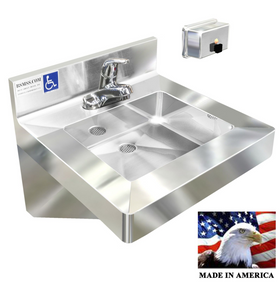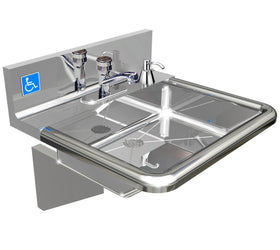Quality Stainless Steel Info
When compared to other metals and alloys, stainless steel is the most resistant to corrosion and will not rust under normal environments. Stainless steel contains chromium, and when exposed to oxygen it forms a thin invisible layer called chromium oxide.
Stainless Steel products, for example; a restaurant sink cannot rust on its own. Rust can form when this layer is damaged from exposure to cleaners, chloride, high humidity, high salinity environments, and/or mechanical abrasions. Rust is caused by a metallic particulate which has oxidized on the surface of a product and turned it to rust. When rust occurs on a product, it resides on the top surface.
Similar to stainless steel, glass enameled cast iron, vitreous china, and Vikrell cannot rust on its own. Rust is not the result of a manufacturing process, nor is it considered a defect in the product. Therefore does not qualify under any warranty. When rust/corrosion occurs it is a direct outcome of stainless steel that does not receive the adequate care and maintenance.
The good news is there are ways to prevent it! Here is the link to our guide: https://bsmss.com/blogs/news/how-to-clean-your-stainless-steel-sink
Common Causes of Rust on Stainless Steel:
|
Improper Cleaning |
When dirt is not removed, or the surface is not thoroughly rinsed and dried after cleaning, it can allow iron – found in most water – to react to the oxygen in the air, causing rust. |
|
Wool or Wire Brush Usage |
When this process is used to clean stainless steel, particles are embedded onto the surface. Rust can form when these particles are exposed to humid air or moisture. |
|
Cleaning Chemicals |
At times, it’s not always the products being used directly on the stainless steel that causes rust. For example, chemicals that are used for cleaning concrete or windows can land on the stainless steel surface and react with the air to form rust. |
|
Transfer of Metals |
In some applications, particulate residue from a plain steel or iron may be transferred onto the surface of a stainless steel part or basket. These plain iron or steel particles can disrupt the protective oxide layer of a stainless steel —ruining its corrosion resistance so that it starts to rust. It is most typical on a new construction site or during the installation. Be cautious and do not share tools between different metal types. |
|
Environmental Factors |
In general stainless steel has a very good resistance to atmospheric corrosion and yet, when analyzing the effect of general corrosion on steel, attention has to be given to corrosivity of atmospheres. There are different unaccounted-for environmental factors. Depending on the location-rural, industrial, marine or their combination-corrosiveness of atmospheres can be significant. Such as the presence of salt and moisture in the air of a business that has a coastal location is one example of an environmental factor that might be missed. |
Maintaining and caring for your stainless steel sinks help keep them in great shape for years to come! If you have any specific questions on care for your sink, feel free to contact us at 909-397-8816 or send us an email at: bestsheetmetalinc@bsmss.com



Leave a comment